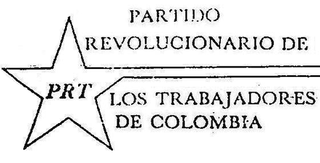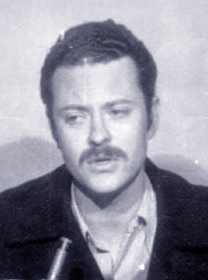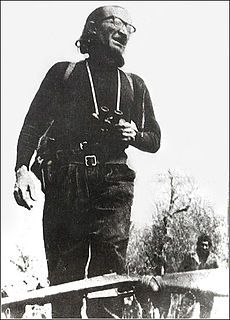
The Túpac Amaru Revolutionary Movement was a Peruvian Marxist-Leninist guerrilla group which started in the early 1980s. Their self-declared goal was to demonstrate to leftist groups in Peru that sought change through the current government the viability of radical revolution. The MRTA also aimed to provide an alternative to another militant group, the Shining Path, which placed them in direct competition. The group was led by Víctor Polay Campos until he was sentenced to 32 years' imprisonment in 1992 and by Néstor Cerpa Cartolini until his death in 1997.
An urban guerrilla is someone who fights a government using unconventional warfare or domestic terrorism in an urban environment.

The Revolutionary Left Movement is a Chilean far-left Marxist-Leninist communist party and former urban guerrilla organization founded on 12 October 1965. At its height in 1973, the MIR numbered about 10,000 members and associates. The group emerged from various student organizations, mainly from University of Concepción, that had originally been active in the youth organization of the Socialist Party. They established a base of support among the trade unions and shantytowns of Concepción, Santiago, and other cities. Andrés Pascal Allende, a nephew of Salvador Allende, president of Chile from 1970 to 1973, was one of its early leaders. Miguel Enríquez Espinosa was the General Secretary of the party from 1967 until his assassination in 1974 by the DINA.
The Revolutionary Left Movement – New Majority is a social democratic political party in Bolivia. It was a member of the Socialist International.

The National Assembly of the Socialist Left was an alliance of far-left groups in Mexico. The only assembly of the socialist left for the creation of a "Socialist Front" was held in Mexico City April 16–17, 2005. The appeal inviting to the meeting was signed by:
The Democratic and Popular Union (1977–84) was a Bolivian umbrella political alliance uniting various smaller left-wing parties. It was formed in 1977 by former president Hernán Siles Zuazo and consisted chiefly of Siles' Movimiento Nationalista Revolutionario de Izquierda, a spin-off of the Moviminento Nacionalista Revolucionario, and Jaime Paz Zamora's Movimiento de Izquierda Revolucionaria. The coalition became extremely popular with Bolivian voters in the late 1970s, due to fatigue with the military dictatorships that for the most controlled the country since 1964.
People's Revolutionary Party is a small political party in Chile. The group has its origins in the Revolutionary Left Movement.
Revolutionary Left is a Trotskyist political party in Spain formerly affiliated with the Committee for a Workers' International (CWI). Revolutionary left publishes El Militante in Spanish, Militant in Catalan and Euskal Herria Sozialista. They contain a socialist perspective on news and current issues. It campaigns for a party of the working class to express the political needs of those not benefiting from the capitalist system. They believe a strong and organized movement of workers and young people can overthrow capitalism and establish a new society. This can be achieved by taking banks and big business into public ownership and administering them through democratic control and management.

Workers Revolutionary Party of Colombia was a political party in Colombia. The party was founded in 1982. It emerged from the 'Majority' faction of the Marxist-Leninist-Maoist Tendency, a group that had broken away from the Communist Party of Colombia (Marxist-Leninist) in the mid-1970s.
Jaime Francisco Sebastián Castillo Petruzzi, known as Torito, is a Chilean former militant of the left-wing organization Movimiento de Izquierda Revolucionaria who worked with the Túpac Amaru Revolutionary Movement during the internal conflict in Peru. He was convicted by a Peruvian military tribunal of high treason in 1993 and sentenced to life in prison. In 2003, after a new trial in accordance with a ruling by the Inter-American Court of Human Rights, Castillo was sentenced to 23 years in prison. He was released on 14 October 2016 and expelled to Chile.

Mario Roberto Santucho was an Argentine revolutionary and guerrilla combatant, founder of the Partido Revolucionario de los Trabajadores and leader of Argentina's largest Marxist guerrilla group, the Ejército Revolucionario del Pueblo.

José Gregorio Liendo Vera, also known as "Compañero Pepe", "Comandante Pepe" or "Loco Pepe" was a Chilean university student, political leader and militant of the Revolutionary Left Movement, a Marxist-Leninist and Guevarist urban guerrilla and political movement, being also leader and member of the "Movimiento Campesino Revolucionario" (MCR), the MIR's Front of the Masses among the Chilean peasantry, participated in the fundos occupations during the government democratically elected socialist President Salvador Allende and the leftist political coalition Unidad Popular in the early 1970s.
Ricardo Letts Colmenares was a Peruvian politician, journalist and left-wing militant.

Bautista van Schouwen Vasey was a medical doctor and one of the founders of the Movement of the Revolutionary Left (MIR), the Chilean guerrilla organization which earliest resisted the Military Coup of Augusto Pinochet in 1973. Five among the "Ten most wanted" opposition figures wanted by the military government after the 11 September coup were militants of MIR. Bautista van Schouwen was at the time member of MIR's "Comisión Política" and the "Secretariado", the highest executive organ of the MIR. The military had set a reward of 500 000 Escudos to anyone who would lead them to the capture of Van Schouwen. He was abducted in Santiago December 13, 1973, in the church Parroquia Capuchinos, after having been caught when the priest who was sheltering them, unwittingly let slip to his military cousins, that they were at the church. Father Enrique White was also detained and tortured, later exiled to England. Van Schouwen and his lieutenant Patricio Munita had previously obtained clandestine refuge in the Capuchinos church-premises. They were soon after their capture killed under torture in the Army-managed detention and torture centre of Villa Grimaldi. The assassinations of Van Schouwen and Munita were however concealed by the Pinochet government and the Van Schouwen case during several years labelled as desaparecido by Human-rights organizations in Chile.

Luis de la Puente Uceda was a Peruvian activist, politician, land reformer, and guerrilla who protested against the political coexistence and coalition between his party, American Popular Revolutionary Alliance (APRA), and the conservative forces who supported the second government of Manuel Prado Ugarteche (1956-1962), and helped pioneer land reform in Peru.
A communist revolution is a proletarian revolution often, but not necessarily, inspired by the ideas of Marxism that aims to replace capitalism with communism. Depending on the type of government, socialism can be used as an intermediate stage to Communism. The idea that a proletarian revolution is needed is a cornerstone of Marxism; Marxists believe that the workers of the world must unite and free themselves from capitalist oppression to create a world run by and for the working class. Thus, in the Marxist view, proletarian revolutions need to happen in countries all over the world.








